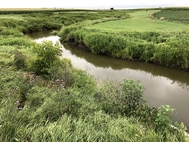
The Legislative- Citizen Commission on Minnesota Resources (LCCMR) is accepting funding proposals through April 15 for projects that protect, conserve, preserve, and enhance Minnesota’s air, water, land, fish, wildlife, and other natural resources. The commission reviews applications and makes funding recommendations to the Minnesota Legislature from the Environment and Natural Resources Trust Fund, derived from lottery proceeds and investment income. About $53 million is anticipated to be available for projects beginning July 1, 2020. Most projects funded are 2-3 years in duration.
Applicants are encouraged to submit draft proposals by March 15 to receive staff feedback. Final proposals must be submitted online at www.lccmr.leg.mn by April 15.
There is no minimum or maximum request amount. The request for proposals is open to all who want to apply and who have demonstrated fiscal capacity. Applicants must be available to make a formal presentation to the commission if selected and be available for staff or commission member questions.
|
The Minnesota Board of Water and Soil Resources (BWSR) recently approved $13.7 million in Clean Water Fund grants to improve water quality in streams, lakes, and groundwater across the state. The majority of the grant funding - $11.7 million - is allocated for voluntary conservation projects across Minnesota. In addition, $1.4 million will support accelerated implementation for high-priority projects, and $610,000 will fund multipurpose drainage management.
The $13.7 million will fund 52 separate grants, 36 of which are dedicated to specific projects and practices. For example, a grant awarded to the Martin Soil and Water Conservation District will support its efforts to improve drinking water in the Fairmont area by implementing agriculture best management practices near the Fairmont Chain of Lakes. Upon project completion, sediment in the chain of lakes is estimated to be reduced by 130 tons each year.
Click below to learn more about the 52 grant recipients:

Gov. Tim Walz, who took the oath of office Jan. 7, has appointed Laura Bishop as commissioner of the Minnesota Pollution Control Agency (MPCA). John Linc Stine stepped down as MPCA commissioner on Jan. 7, capping 40 years of state service. His tenure included time at the Minnesota Departments of Natural Resources and Health, and the last seven years at the MPCA.
Bishop, in photo at right, most recently served as chief corporate responsibility and sustainability officer for Best Buy Co., an American multinational consumer electronics retailer headquartered in Richfield, Minn. Prior to her 15 years at Best Buy, Bishop was an assistant commissioner for the Minnesota Department of Administration under Gov. Jesse Ventura. Prior to that, she was special assistant to the Ambassador of Switzerland and Office of the White House Liaison to the U.S. Department of Education under President Bill Clinton.
In her initial statements, Bishop said she is glad to be back at the State of Minnesota:
“When I left state government in 2003 to work for Best Buy, one of the first issues I was asked to help address related to electronics recycling, where I got to know and appreciate the work of the MPCA. While I held different roles at Best Buy, my most recent role was leading the environmental sustainability and compliance divisions and helped lead the company’s efforts to reduce its environmental impact and help consumers live more sustainably.
“I grew up in Minnesota spending most of my summers at a cabin in Aitkin County that my dad and uncle. both public school teachers, helped build. And it was this upbringing that helped me appreciate the environment and also understand well the impacts the changing climate has on our lakes, air and quality of life.
“Minnesota is a leader in environmental stewardship, but the changing climate demands we do more to ensure the availability and health of the vital resources all Minnesotans value. I look forward to joining the Walz-Flanagan Administration and working alongside stakeholders to find common ground solutions that protect and improve our environment and build a more sustainable and just future.”
Bishop holds a bachelor’s degree from the University of Wisconsin-Madison and a master’s degree in public administration from the University of Michigan. She lives in Eden Prairie with her husband Chuck Weber, an attorney with the Hennepin County Attorney’s Office, and their two teenage daughters.
|
Based on new studies available for public review and comment, the MPCA and local watershed partners are recommending stream and ditch restoration projects, and that landowners implement voluntary management practices to reduce water pollution in the Grand Marais Creek and Two Rivers watersheds. The TMDL studies quantify the recent pollutant levels in waterbodies, identify pollution sources, and propose ways to return water quality to an acceptable level. In contrast, the WRAPS reports identify impaired water bodies and those in need of protection, and identify actions needed to achieve and maintain water quality.

Grand Marais Creek watershed
The Grand Marais Creek studies found that land alterations designed to promote soil drainage, such as stream channelization and ditching, have had a negative impact on water quality, fish and aquatic insect communities, and recreation.
Impairments to fish and aquatic insect communities are caused by low dissolved oxygen, excessive sediment and E. coli bacteria levels. Excessive E. coli levels also caused streams to be impaired for recreation.
Grand Marais Creek watershed encompasses 592 square miles in Polk, Pennington and Marshall counties in northwest Minnesota. The majority of land in the watershed is privately owned and farmed, with 92% planted in crops. While landowners have long been engaged in good land stewardship practices, the Grand Marais Creek Total Maximum Daily Load (TMDL) and Watershed Restoration and Protection Strategy (WRAPS) reports recommend widespread changes to restore and protect streams and ditches. These include additional stream and ditch restoration projects, and increased use of buffer strips and crop rotation.
Comments on the draft reports should be sent to Denise Oakes, 714 Lake Ave., Suite 220, Detroit Lakes, MN 56501; or by email to, denise.oakes@state.mn.us. If you have questions, she can be reached by phone, 218-846-8119. Comments must be received by 4:30 p.m. on Jan. 26.
More information is also available from Corey Hanson, Red Lake River Watershed District, 218-681-5800; Nicole Bernd, West Polk County SWCD, 218-281-6070; and Joel Praska, Middle/Snake/Tamarac River Watershed District, 218-745-4741.
|

Two Rivers watershed
The Two Rivers watershed studies found that about 79% of streams in the watershed have been altered to promote soil drainage. Alterations such as stream channelization and ditching have had a negative impact on water quality, and on fish and aquatic insect communities affected by low flows, low dissolved oxygen levels and poor habitat.
In addition, some stream reaches are impaired for human recreation due to excessive levels of E. coli bacteria.
Located in northwest Minnesota, this watershed encompasses 1,098 square miles in Roseau, Kittson, and Marshall counties. The majority of land in the watershed is privately owned and farmed, about 63% is used to grow crops. While landowners have long been engaged in good land stewardship practices, the Two Rivers Total Maximum Daily Load (TMDL) Study and Watershed Restoration and Protection Strategy (WRAPS) report recommend widespread changes to restore and protect water quality and aquatic life in streams and ditches. These include increased use of water impoundments, buffer strips, and other actions to reduce erosion and runoff.
Comments on the draft reports should be sent to Danielle Kvasager, 714 Lake Ave., Suite 220, Detroit Lakes, Minn. 56501; by email, danielle.kvasager@state.mn.us. For more information, call her at 218-846-8117. Comments must be received by 4:30 p.m. on Jan. 23.
|
As part of recognizing the 10 years of the Clean Water Fund, BWSR is highlighting 10 projects that received grants from the Legacy Amendment fund.

With help from the Root River SWCD, Josh and Steph Dahl are making to their 160-cow dairy through the Root River Field to Stream Partnership that will position their fourth-generation farm for the future. The Minnesota Department of Agriculture-led venture uses intensive data collection to determine what effect specific conservation practices have on water quality. Clean Water Fund grants help farmers implement those practices. Outcomes apply to watersheds throughout southeastern Minnesota.
The Goodhue SWCD is using grant money to build upland dams to stop gully erosion and retain topsoil, helping keep sediment out of trout streams that enter the Mississippi River and Lake Pepin. The prioritized work centered on spots where conservation fixes would do the most to improve water quality and stream habitat. “It’s kind of a showcase of what other watersheds could do — and that we should be doing here — to help address that sediment issue in Lake Pepin,” said Beau Kennedy, Goodhue SWCD water planner.
On a South Fork Vermillion River tributary where monitoring showed increasing nitrate levels, a pilot treatment project is underway, thanks to a grant to the Vermillion River Watershed Joint Powers Organizations in Dakota County. If it proves effective, it could be used elsewhere in the Vermillion River watershed. Nitrate contributes to water-quality problems in local rivers and in Hastings-area drinking water supplies. A wood chip-enhanced wetland at the edge of a Dakota County farm field will treat water with some of the highest nitrate levels in the watershed.
In East Polk County, erosion control structures are keeping topsoil in fields and out of the Sand Hill River. Since 2011, farmers have installed 133 water and sediment control basins that keep about 426 dump truck loads of sediment out of the river annually. “Not only are we reducing the sediment load that’s going into the rivers, streams and wetlands, but the farmers are now able to farm the land most effectively,” said Jim Hest, Red River Valley Conservation Service engineer.
|

In the Buffalo-Red River Water District, funding is helping restore 21 miles of Wolverton Creek with water quality benefits that will extend to the Red River. The restoration will improve drainage, widen habitat corridors, curb soil erosion and flood damage to fields, and cut Fargo-Moorhead’s drinking water treatment costs. The project leverages Clean Water Fund dollars. “Community-wide, there’ll be better habitat. There’ll be better drainage. Water quality. We won’t be dumping as much sediment load in — and that goes all the way to the river and all the way north,” said Wilkin County farmer Jay Nord.
“If they were easily fixed, we wouldn’t get them,” said Sheila Craig, southern region community sewage treatment facilitator for the 14-county Southeast Minnesota Wastewater Initiative. Clean Water Funds help pay for her position. She helps small communities with failing septic systems choose a solution and secure grants to help pay for it. Work in Olmsted County connected 23 Cedar Beach homes to a shared sewage treatment system, protecting groundwater and the Zumbro River.
Detroit Lake is among 12 phosphorus-sensitive lakes in Becker County with water quality in peril or warranting preservation. Clean Water Funds help shoreland property owners install native plant restorations, rain gardens and gutters — which help cut the amount of phosphorus that enters the water. “If Detroit Lake ever flipped it would be disastrous all the way downstream because everybody’s kind of at their tipping point already,” said Peter Mead, Becker SWCD administrator.
A new carp removal system tested on Rice Creek in Ramsey County could change the way Minnesota deals with the invasive fish that degrade lakes’ water quality and habitat. The system combines technology used in Poland to keep fish out of hydroelectric plants with technology developed in the U.S. to pick fruit. It’s one element of the four-part Long Lake Targeted Watershed Demonstration Project, a plan to improve water quality in nutrient-impaired Long Lake in the Rice Creek Watershed District.
The 20 red clay dams built during the 1970s in the Nemadji River watershed kept highly erodible soil from reaching Lake Superior. With Clean Water Fund grants and willing landowners, the Carlton SWCD is tackling failed red clay dams that could unleash 30 years worth of accumulated sediment. Restoration and bank stabilization projects bring trout anglers’ hopes of stocked streams closer to reality, as habitat improves and fish passage is restored upstream from Lake Superior.
The Bois de Sioux Watershed District’s first ditch retrofit, on Traverse County Ditch 37 near Wheaton, could be the first of many retrofits designed to improve water quality in rivers and streams and alleviate flooding on fields. A Clean Water Fund grant is in play. Farming accounts for 93% of land use in the 1,400-square-mile watershed, which includes parts of six west-central Minnesota counties. The ditch drains into Twelvemile Creek, the Mustinka River and Lake Traverse. Click to edit this placeholder text.
|

The MPCA is seeking college students, technicians and crew leaders to assess the water quality of streams this summer in the Brainerd and St. Paul areas. Crews will sample about 50 sites for fish, invertebrates, habitat and water chemistry. Student workers and technicians must be college students majoring in a water-related science, environmental protection or related degree field. Crew leaders must meet additional requirements.
For more information and to apply, go to www.mn.gov/careers:
- Crew leader - Job ID # 28678 (St. Paul) or 28686 (Brainerd)
- Technician - Job ID # 28675 (St. Paul) or 28688 (Brainerd)
- College student worker - Job ID # 28694 (St. Paul) or 28689 (Brainerd)
Applications are due Jan. 22.
|
|